You know from our weekly traveling foodie newsletter (BellyHustle), that we are obsessed with food. From our experiences in many different countries, we know that food can be so much more than just what we use to fulfill our hunger. It is an expression of individuality, character, and even of an entire culture.
These are my choices for the 7 best food books that will not only make your mouth water and your hands crave to be put to use chopping and dicing, but that will challenge you to think differently.
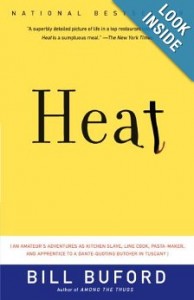
 1) Heat: An Amateur’s Adventures as Kitchen Slave, Line Cook, Pasta-Maker, and Apprentice to a Dante-Quoting Butcher in Tuscany
1) Heat: An Amateur’s Adventures as Kitchen Slave, Line Cook, Pasta-Maker, and Apprentice to a Dante-Quoting Butcher in Tuscany
by Bill Buford
As soon as I finished reading it, I marked it as a book that I must read at least once every year. It starts with the author doing a piece on Mario Batali for the New Yorker Magazine and becoming fascinated with the life of those who work in the kitchen. In order to get a better feel for what he is writing about, he works in Batali’s kitchens for a week, then a month, and then a year. What started as a writing assignment takes the author on a culinary adventure from the kitchens of Babbo to a grandma’s house in Italy and finally to a butcher shop in Chianti. He also intersperses his story with the story of how Mario Batali became the bigger than life character we see today. Let’s just say Batali’s capacity to imbibe both legal and illegal drugs is legendary…
Read this for the fantastic journey taken by Bill Buford, but also for the incredible stories of people who strive to their one thing supremely well.
An accurate motto for our eating rampage through Europe last year:
This year, Mario was trying out a new motto: “Wretched excess is just barely enough.”
A taste of the book:
“I’ve often thought that food is a concentrated messenger of a culture, compacted into the necessity of our having to eat to survive, and I felt this powerfully as I read these mementos from another generation and listened to Armandino’s children talk about the eccentric-seeming recipes of their grandmother, who had learned them in the back room of a food store in Seattle from her mother, who, in turn, had learned them from her mother in a house in a village in Abruzzo.”
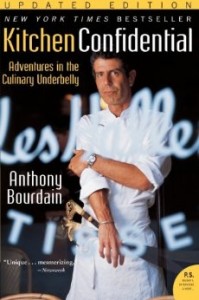
 2) Kitchen Confidential:
2) Kitchen Confidential:
Adventures in the Culinary Underbelly
by Anthony Bourdain
The one food book that is recognized by more people I mention it to than any other, but it’s popularity shouldn’t stop you from cracking it open. An honest brutality permeates the pages as Bourdain holds nothing back about himself or other chefs. This book almost single-handidly created the Chef as Hero/Celebrity culture that we now all watch on TV.
Read this if you ever wanted to know what working in a kitchen looks and feels like, but also if you want to know what succeeding through struggle (both externally and internally generated) looks likes.
What I say to myself before eating any Thai street food:
“And I’ve long believed that good food, good eating is all about risk.”
A taste of the book:
“Do we really want to travel in hermetically sealed popemobiles through the rural provinces of France, Mexico and the Far East, eating only in Hard Rock Cafes and McDonalds? Or do we want to eat without fear, tearing into the local stew, the humble taqueria’s mystery meat, the sincerely offered gift of a lightly grilled fish head? I know what I want. I want it all. I want to try everything once.”
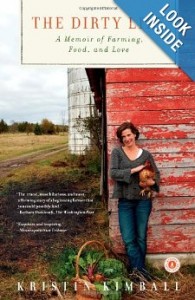
 3) The Dirty Life: A Memoir of Farming, Food, and Love
3) The Dirty Life: A Memoir of Farming, Food, and Love
by Kristin Kimball
A book that I discovered one late night on Meg’s Kindle and didn’t put down until I had finished it early the next morning. A fairly straight forward fish out of water tale, but told so perfectly that it almost makes you want to quit what you’re doing and start a farm… right now. A chance meeting with a man passionate about locally grown produce leads Kristin Kimball into a fierce love affair that would take her from the city life she loves, to running an organic farm and am upstart CSA. Her journey from less-than-amateur gardener to professional farmer is told with such a strong narrative that you are dying to find out if the farm survives it’s struggles and if she actually gets married. But she also sprinkles in some incredible food descriptions and makes eating simple ingredients sound extravagant.
Read this for the gripping story and descriptions of food, but also if you want to be inspired by people taking big risks and working hard to succeed.
A dose of inspiration:
“In his view, we were already a success, because we were doing something hard and it was something that mattered to us. You don’t measure things like that with words like success or failure, he said. Satisfaction comes from trying hard things and then going on to the next hard thing, regardless of the outcome. What mattered was whether or not you were moving in a direction you thought was right.”
A taste of the book:
“But raw milk from a Jersey cow is a totally different substance from what I’d thought of as milk. If you do not own a cow or know someone who owns a cow, I must caution you never to try raw milk straight from the teat of a Jersey cow, because it would be cruel to taste it once and not have access to it again. Only a few people in America remember this type of milk now, elderly people mostly, who grew up with a cow. They come to the farm sometimes, looking for that taste from their childhood.”
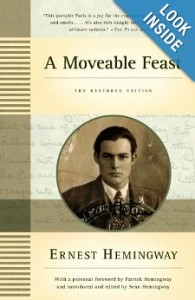
 4) A Moveable Feast
4) A Moveable Feast
by Ernest Hemingway
A bit of a cheat, but I don’t care. This is my list and if I say it’s about food, then it is! While this book is about many things, it is Hemingway’s food descriptions that I always come back to. Like everything he writes, they are simple, powerful, and without fluff. His rhythmic writing comes closest to describing how I feel when you have that perfect bite of food or sip of wine. Where everything falls into place: The light, the place, and the food.
Read this to see an incredible portrait of 1920’s Paris, but also how Hemingway viewed food and wine as a way to complete an unfulfilled soul.
Something to forward to your favorite wine by the bottle drinker:
“Wine is the most civilized thing in the world. In Europe we thought of wine as something as healthy and normal as food and also a great giver of happiness and well being and delight. Drinking wine was not a snobbism nor a sign of sophistication nor a cult; it was as natural as eating and to me as necessary.”
A taste of the book:
“As I ate the oysters with their strong taste of the sea and their faint metallic taste that the cold white wine washed away, leaving only the sea taste and the succulent texture, and as I drank their cold liquid from each shell and washed it down with the crisp taste of the wine, I lost the empty feeling and began to be happy and to make plans.”
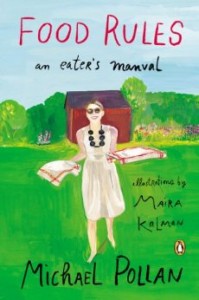
 5) Food Rules: An Eater’s Manual
5) Food Rules: An Eater’s Manual
by Michael Pollan (illustrated by Maira Kalman)
One of the first non-fiction books I ever read on food, it is a simple, short book filled with cute and easy to remember phrases to help people eat better and healthier. I still remember his rule that anything with more than 5 ingredients is most likely processed, so just stick to food’s with less than 5. Now that the great Maira Kalman has updated the book with beautiful illustrations, it is the perfect book to read again.
Read this if want easy to remember rules on how to eat better, but also if you want to see how to take something complex and make it ridiculously simple.
The one rule I have serious trouble following:
“Use the apple test… If you’re not hungry enough to eat an apple, you’re not hungry.”
A taste of the book: 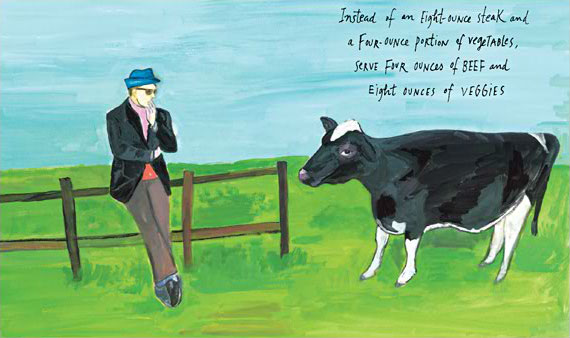
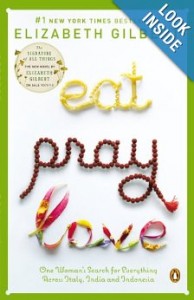
 6) Eat, Pray, Love: One Woman’s Search for Everything Across Italy, India and Indonesia
6) Eat, Pray, Love: One Woman’s Search for Everything Across Italy, India and Indonesia
by Elizabeth Gilbert
Yeah, yeah, yeah. Man card revoked. Whatever. Thanks for visiting us from the 1990’s. Gilbert’s book is many things: a classic hero story of self-discovery, a meditation on place and the power of travel, and about the power of food. I obviously was pulled towards that last part and her perfectly expressed anecdotes on food will make you want to hop on a plane and get in line at whatever restaurant she is mentioning.
Read this if you’re obsessed with food and want to live vicariously through someone who traveled to Italy to eat, but also if you want to read about a charmingly told story of someone in search of self.
How Meg makes me jealous: 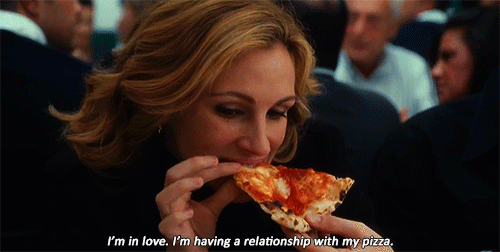 A taste of the book:
A taste of the book:
“I walked home to my apartment and soft-boiled a pair of fresh brown eggs for lunch. I peeled the eggs and arranged them on a plate beside the seven stalks of asparagus (which were so slim and snappy they didn’t need to be cooked at all). I put some olives on the plate, too, and the four knobs of goat cheese I’d picked up yesterday from the formaggeria down the street, and two slices of pink, oily salmon.
For dessert—a lovely peach, which the woman at the market had given to me for free and which was still warm from the Roman sunlight. For a while I couldn’t even touch the food for it was a masterpiece of lunch, a true expression of the art of making something out of nothing. Finally, when I had fully absorbed the prettiness of my meal, I went and sat in a patch of sunbeam on my clean wooden floor and at every bite of it, with my fingers, while reading my daily newspaper article in Italian. Happiness inhabited my every molecule.”
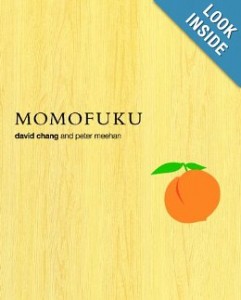
 7) Momofuku
7) Momofuku
by David Chang and Peter Meehan
Written by Momofuku’s founding chef and his business partner, this book is many things.
Named after their most famous restaurant in NYC, it has succulent recipes throughout, tips on how to cook better, and the story of how David Chang went from an unhappy office worker to a culinary sensation. A great read on all levels.
Read this for the recipes and the tips on cooking, but also to be inspired by entrepreneurial spirit of David Chang and his constant desire to innovate and improve.
Why it’s like no other cookbook:
“If you fuck up, you fucked up a piece of meat that cost a lot of money. That somebody took care to raise and slaughter and dry-age and butcher. That makes you an asshole”
A taste of the book:
“Our ginger scallion noodles are an homage to/out-and-out rip-off of one of the greatest dishes in New York City: the $4.95 plate of ginger scallion noodles at Great New York Noodletown down on the Bowery in Chinatown.
Ginger scallion sauce is one of the greatest sauces or condiments ever. Ever. It’s definitely a mother sauce at Momofuku, something that we use over and over and over again. If you have ginger scallion sauce in the fridge, you will never go hungry: stir 6 tablespoons into a bowl of hot noodles–lo mein, rice noodles, Shanghai thick noodles–and you’re in business. Or serve over a bowl of rice topped with a fried egg. Or with grilled meat or any kind of seafood. Or almost anything.”
Did you enjoy this list?
If you did, you’re probably obsessed with food… so you should sign up for our weekly BellyHustle newsletter where we share delicious food stories, cool food facts, and unique deals just for subscribers.

nice list, I can’t wait to read Heat!
Heat is so so so good. I am going to reread it soon. It will definitely make you want to head back to the tuscan countryside and take up an apprenticeship in a butcher shop.
Just signed up to your newsletter Food is such an important consideration of our daily lives and even more so I think when travelling for a number of reasons.
Food is such an important consideration of our daily lives and even more so I think when travelling for a number of reasons.
Totally agree Jacqui!
Food shaped our travels to an incredible degree and even cemented friendships. We also were able to learn so much about other cultures through discussions of food and for some reason, language barriers seem to melt away when excitedly describing your favorite ingredient in a new dish…
Thanks for signing up!
-Tony
Comments on this entry are closed.